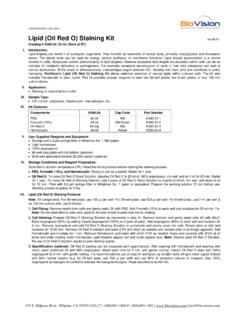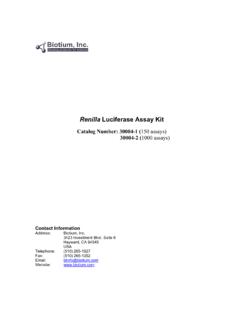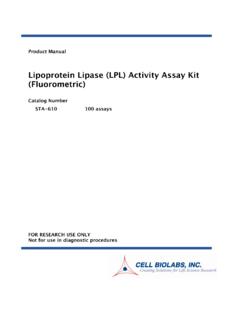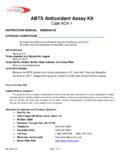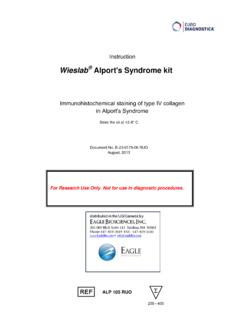Transcription of Caspase-3/CPP32 Colorimetric Assay Kit - Biovision
1 Biovision rev. 10/11 Biovision Research Products Tel: 650-428-0236 Fax: 650-428-0336 980 Linda Vista Avenue, Mountain View, CA 94043 USA Page 1 For research use only Caspase-3/CPP32 Colorimetric Assay Kit (Catalog #K106-25, -100, -200, -400; Store kit at 20 C) I. Introduction: Activation of ICE-family proteases/caspases initiates apoptosis in mammalian cells. The Caspase-3/CPP32 Colorimetric Assay Kit provides a simple and convenient means for assaying the activity of caspases that recognize the sequence DEVD.
2 The Assay is based on spectrophotometric detection of the chromophore p-nitroaniline (pNA) after cleavage from the labeled substrate DEVD-pNA. The pNA light emission can be quantified using a spectrophotometer or a microtiter plate reader at 400- or 405-nm. Comparison of the absorbance of pNA from an apoptotic sample with an uninduced control allows determination of the fold increase in CPP32 activity. II. Kit Contents: Components K106-25 K106-100 K106-200 K106-400 Part Number 25 assays 100 assays 200 assays 400 assays Cell Lysis Buffer 25 ml 100 ml 100 ml 100 ml K106-XX(X)-1 2X Reaction Buffer 2 ml 4 x 2 ml 16 ml 32 ml K106-XX(X)-2 DEVD-pNA (4 mM) 125 l ml 2 x ml 2 x 1 ml K106-XX(X)-3 DTT (1 M) 100 l ml ml ml K106-XX(X)-4 Dilution Buffer 25 ml 100 ml 200 ml 400 ml K106-XX(X)-5 III. Caspase-3 Assay Protocol: A. General Considerations Aliquot enough 2X Reaction Buffer for the number of assays to be performed.
3 Add DTT to the 2X Reaction Buffer immediately before use (10 mM final concentration: add 10 l of M DTT stock per 1 ml of 2X Reaction Buffer). Protect DEVD-pNA from light. B. Assay Procedure 1. Induce apoptosis in cells by desired method. Concurrently incubate a control culture without induction. 2. Count cells and pellet 1-5 x 106 cells. 3. Resuspend cells in 50 l of chilled Cell Lysis Buffer and incubate cells on ice for 10 minutes. 4. Centrifuge for 1 min in a microcentrifuge (10,000 x g). 5. Transfer supernatant (cytosolic extract) to a fresh tube and put on ice for immediate Assay or aliquot and store at 80 C for future use. 6. Assay protein concentration. 7. Dilute 50-200 g protein to 50 l Cell Lysis Buffer for each Assay . 8. Add 50 l of 2X Reaction Buffer (containing 10 mM DTT) to each sample. 9. Add 5 l of the 4 mM DEVD-pNA substrate (200 M final conc.)
4 And incubate at 37 C for 1-2 hour. 10. Read samples at 400- or 405-nm in a microtiter plate reader, or spectrophotometer using a 100- l micro quartz cuvette (Sigma), or dilute sample to 1 ml with Dilution Buffer and using regular cuvette (note: Dilution of the samples proportionally decreases the reading). Fold-increase in CPP32 activity can be determined by comparing these results with the level of the uninduced control. Note: Background reading from cell lysates and buffers should be subtracted from the readings of both induced and the uninduced samples before calculating fold increase in CPP32 activity IV. Storage and Stability: Store kit at 20 C (Store Lysis Buffer, Reaction Buffer, and Dilution Buffer at 4 C after opening). All reagents are stable for at least 6 months under proper storage conditions. VI. Related Products: Apoptosis Detection Kits & Reagents Annexin V Kits & Bulk Reagents Caspase Assay Kits & Reagents Mitochondrial Apoptosis Kits & Reagents Nuclear Apoptosis Kits & Reagents Apoptosis Inducers and Set Cell Fractionation System Mitochondria/Cytosol Fractionation Kit Nuclear/Cytosol Fractionation Kit Membrane Protein Extraction Kit Cytosol/Particulate Rapid Separation Kit Mammalian Cell Extraction Kit FractionPREP Fractionation System Cell Proliferation & Senescence Quick Cell Proliferation Assay Kit Senescence Detection Kit High Throughput Apoptosis/Cell Viability Assay Kits LDH-Cytotoxicity Assay Kit Bioluminescence Cytotoxicity Assay Kit Live/Dead Cell Staining Kit Induction of Caspase-3 Activity by Anti-Fas Antibody in Jurkat T Cells Using Caspase-3 Colorimteric Assay Kit K106-25 Uninduced Induced Biovision rev.
5 10/11 Biovision Research Products Tel: 650-428-0236 Fax: 650-428-0336 980 Linda Vista Avenue, Mountain View, CA 94043 USA Page 2 For research use only GENERAL TROUBLESHOOTING GUIDE FOR CASPASE Colorimetric AND FLUOROMETRIC KITS: Problems Cause Solution Assay not working Cells did not lyse completely Resuspend the cell pellet in the lysis buffer and incubate as described in the datasheet Experiment was not performed at optimal time after apoptosis induction Perform a time-course induction experiment for apoptosis Plate read at incorrect wavelength Check the wavelength listed in the datasheet and the filter settings of the instrument Old DTT used Always use freshly thawed DTT in the cell lysis buffer High Background Increased amount of cell lysate used Refer to datasheet and use the suggested cell number to prepare lysates Increased amounts of components added due to incorrect pipetting Use calibrated pipettes Incubation of cell samples for extended periods Refer to datasheet and incubate for exact times Use of expired kit or improperly stored reagents Always check the expiry date and store the individual components
6 Appropriately Contaminated cells Check for bacteria/ yeast/ mycoplasma contamination Lower signal levels Cells did not initiate apoptosis / Assay not done at optimal timepoint after induction of apoptosis Determine the time-point for initiation of apoptosis after induction (time-course experiment) Very few cells used for analysis Refer to datasheet for appropriate cells number Use of samples stored for a long time Use fresh samples or aliquot and store and use within one month for the Assay Incorrect setting of the equipment used to read samples Refer to datasheet and use the recommended filter setting Allowing the reagents to sit for extended times on ice Always thaw and prepare fresh reaction mix before use Samples with erratic readings Uneven number of cells seeded in the wells Seed only equal number of uniformly suspended healthy cells (correct passage number) Samples prepared in a different buffer Use the cell lysis buffer provided in the kit Adherent cells dislodged and lost at the time of experiment Perform experiment gently and in duplicates/triplicates; apoptotic cells may become floaters Cell/ tissue samples were not completely homogenized Use Dounce homogenizer (increase the number of strokes).
7 Observe efficiency of lysis under microscope Samples used after multiple freeze-thaw cycles Aliquot and freeze samples, if needed to use multiple times Presence of interfering substance in the sample Trouble-shoot as needed Use of old or inappropriately stored samples Use fresh samples or store at correct temperatures until use Unanticipated results Measured at incorrect wavelength Check the equipment and the filter setting Cell samples contain interfering substances Trouble shoot if it interferes with the kit (run proper controls) General issues Improperly thawed components Thaw all components completely and mix gently before use Incorrect incubation times or temperatures Refer to datasheet & verify the correct incubation times and temperatures Incorrect volumes used Use calibrated pipettes and aliquot correctly Air bubbles formed in the well/tube Pipette gently against the wall of the well/tubes or spin down the plate Substituting reagents from older kits/ lots Use fresh components from the same kit Use of a different 96-well plate Fluorescence: Black plates; Absorbance: Clear plates Note# The most probable cause is listed under each section.
8 Causes may overlap with other sections.


